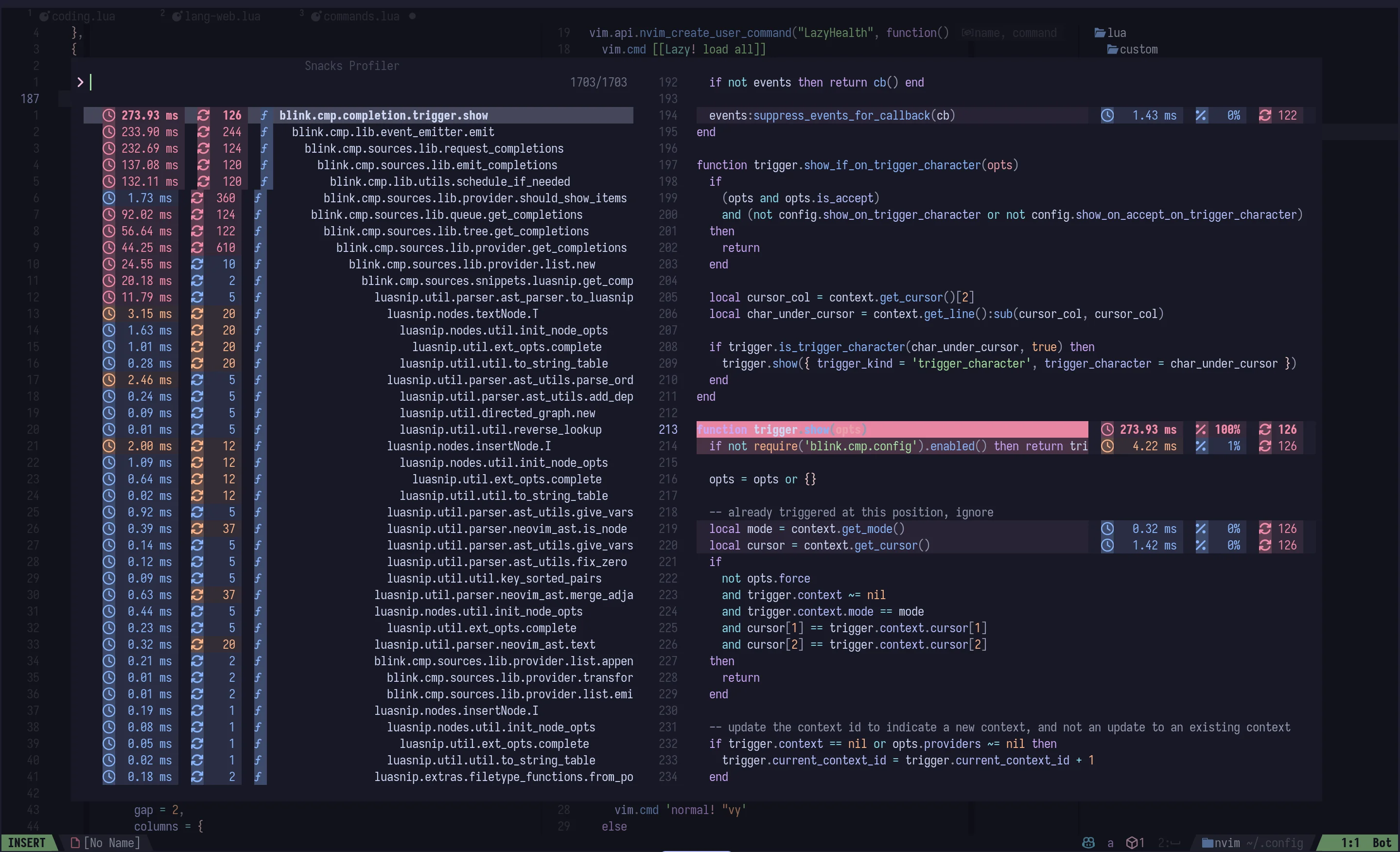How to Track Down the Lag
First, try to reproduce the freeze or lag. Once you can consistently trigger the sluggishness, start disabling your custom plugins, autocmds, and options until you pinpoint the culprit.
But what if nothing seems to work? What if the lag only appears after hours of coding? Then my friend, profile.nvim is your new best buddy. When you notice lag consistently, fire up profile.nvim to capture everything nvim executes. Just keep the recording short—long enough to catch what happens between your keystrokes.
Next, pass the generated profile.json to a GUI like Perfetto UI. There, you can see which functions run when you press j (or any key) and how long they take, ultimately revealing the sneaky offender.

EDIT (March 27, 2025): snacks.nvim includes a profiler tool, which I prefer over profile.nvim.
Tweaking options
Disabling built-in syntax highlighting
I set syntax to manual so that I can still use nvim’s built-in syntax for filetypes that lack treesitter support. This configuration lets you manually enable syntax for those filetypes with an autocmd:
vim.cmd.syntax("manual")
Whenever a filetype doesn’t support treesitter, you can enable its syntax using the following autocmd:
vim.api.nvim_create_autocmd("FileType", {
pattern = { "gitsendemail", "conf", "editorconfig", "qf", "checkhealth", "less" },
callback = function(event)
vim.bo[event.buf].syntax = vim.bo[event.buf].filetype
end,
})
Setting synmaxcol
The synmaxcol option limits how much of a long horizontal line is highlighted by nvim’s syntax engine. This setting is especially useful when opening files with extremely long lines, as it prevents nvim from freezing while attempting to highlight the entire line:
vim.opt.synmaxcol = 500
Managing Signs
Try to avoid enabling signs where possible, as they can add performance overhead—especially when used with custom status column plugins like statuscol.nvim. For instance, I disable diagnostic signs since I often have numerous diagnostics (hints and warnings) on screen. Similarly, with plugins like gitsigns.nvim, showing signs for new files can also impact performance.
Disabling Inlay Hints in Insert Mode
Inlay hints execute on every keystroke. If your language server protocol (LSP) is performing poorly, these frequent updates can block nvim. To mitigate this issue, disable inlay hints when entering insert mode and re-enable them upon leaving:
vim.api.nvim_create_autocmd("InsertEnter", {
pattern = "*",
callback = function(event)
vim.schedule(function()
vim.lsp.inlay_hint.enable(false, { bufnr = event.buf })
end)
end,
})
vim.api.nvim_create_autocmd("InsertLeave", {
group = utils.augroup("enable_inlay_hints"),
pattern = "*",
callback = function(event)
vim.schedule(function()
vim.lsp.inlay_hint.enable(true, { bufnr = event.buf })
end)
end,
})
LSP
Since I spend most of my time juggling React and Vue, here’s a quick tip: if you’re using the eslint LSP, configure it to run only on save—because ain’t nobody got time for constant linting. Also, consider ditching ts_ls in favor of vtsls; your editor (and your sanity) will thank you.
-- eslint LSP config
{
settings = {
run = "onSave",
}
}
Some LSPs can return a large number of completions, such as vtsls. This may cause your completion plugin (e.g., blink.cmp, nvim-cmp) to lag. To prevent this, you should limit the number of completions returned by the LSP. For example, to restrict the number of completions provided by vtsls, you can modify its configuration as follows:
-- vtsls LSP config
{
settings = {
vtsls = {
experimental = {
completion = {
enableServerSideFuzzyMatch = true,
entriesLimit = 20,
},
},
},
},
}
Tweaking Plugins
nvim-treesitter
Disable nvim-treesitter highlighting for files that are either too large or detected as minified. This prevents performance issues when processing such files. Also, disable additional_vim_regex_highlighting:
highlight = {
enable = true,
additional_vim_regex_highlighting = false,
disable = function(_, bufnr)
-- Return true if the buffer is a minified file or if its size is too large.
end,
},
You can view my implementation of the
treesitter.highlight.disablefunction here and here.
nvim-tree.lua
Be sure to check out the “Performance Tips” on its wiki page. If you have filesystem_watchers enabled, make sure to ignore directories with a large number of files, such as node_modules. Additionally, disable the modified option since it can cause lag in large codebases:
{
filesystem_watchers = {
enable = true,
-- I personally ignore the `.git` and `.direnv` directories since I use https://direnv.net
ignore_dirs = { "node_modules", ".direnv", ".git" },
},
modified = {
enabled = false
}
}
snacks.nvim
I highly recommend replacing certain plugins with their Snacks counterparts, as Snacks is blazingly fast, for example:
